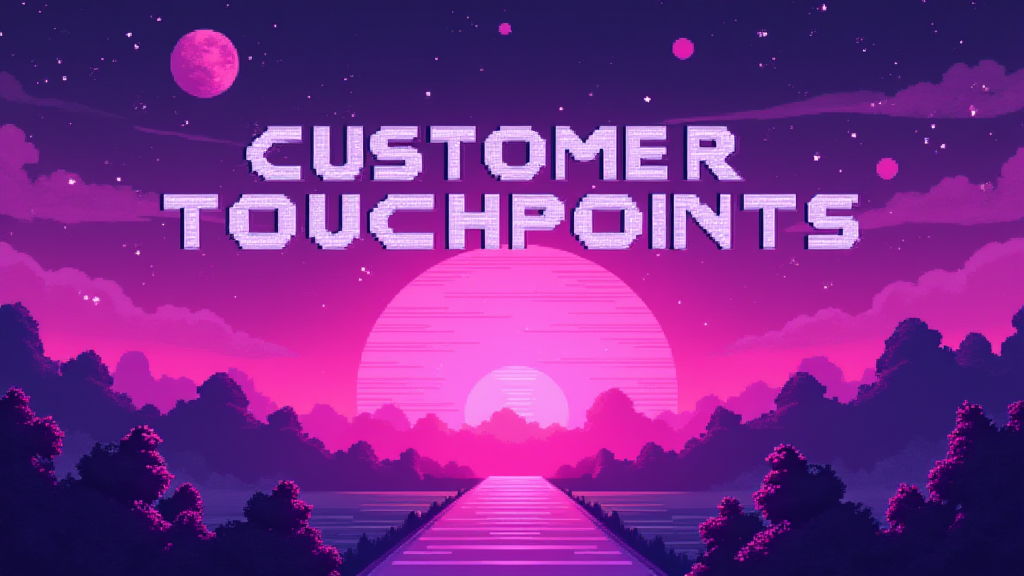Customer Touchpoints: Key to Customer Experience

Published on: October 01, 2024
Customer touchpoints are the building blocks of the customer journey, influencing perceptions, decisions, and ultimately, customer loyalty. By understanding and optimizing these touchpoints, businesses can create a seamless and positive experience that drives customer satisfaction and revenue growth.
Understanding Customer Touchpoints 🔍
Customer touchpoints can be categorized into three main types:
- Company-owned touchpoints: Interactions directly controlled by the company, such as websites, social media profiles, and marketing materials.
- Customer-owned touchpoints: Interactions initiated by the customer, like product usage or social media mentions.
- Partner-owned touchpoints: Interactions with third-party entities associated with the company, such as resellers or affiliate marketers.
These touchpoints occur across various stages of the customer journey:
- Awareness
- Consideration
- Purchase
- Retention
- Advocacy
The Importance of Mapping Customer Touchpoints 🗺️
Creating a comprehensive map of customer touchpoints is essential for several reasons:
- Identifies gaps in the customer experience
- Highlights opportunities for improvement
- Aligns marketing and sales efforts
- Enhances customer satisfaction and loyalty
To create an effective touchpoint map, consider using a table format to organize the information:
| Journey Stage | Touchpoint | Channel | Owner | Goal |
|---|---|---|---|---|
| Awareness | Social Media Ad | Marketing | Generate Interest | |
| Consideration | Product Demo | Webinar | Sales | Showcase Features |
| Purchase | Checkout Process | Website | E-commerce | Facilitate Purchase |
Optimizing Customer Touchpoints for Success 🚀
To maximize the impact of customer touchpoints, consider the following strategies:
- Personalization: Tailor interactions based on customer data and preferences.
- Consistency: Ensure a cohesive brand experience across all touchpoints.
- Omnichannel approach: Integrate touchpoints across various channels for a seamless experience.
- Emotional connection: Create memorable interactions that resonate with customers on an emotional level.
- Continuous improvement: Regularly analyze and optimize touchpoints based on customer feedback and data.
Measuring the Impact of Customer Touchpoints 📊
To gauge the effectiveness of your customer touchpoints, consider tracking the following metrics:
- Customer Satisfaction Score (CSAT)
- Net Promoter Score (NPS)
- Customer Effort Score (CES)
- Conversion rates
- Customer Lifetime Value (CLV)
By monitoring these metrics, you can identify areas for improvement and measure the ROI of your touchpoint optimization efforts.
Challenges in Managing Customer Touchpoints 🤔
While optimizing customer touchpoints is crucial, it comes with its own set of challenges:
- Maintaining consistency across multiple channels
- Balancing personalization with privacy concerns
- Keeping up with rapidly evolving customer expectations
- Integrating data from various touchpoints for a holistic view
- Allocating resources effectively across different touchpoints
Overcoming these challenges requires a strategic approach, cross-functional collaboration, and a commitment to continuous improvement.
The Future of Customer Touchpoints 🔮
As technology continues to evolve, so do customer touchpoints. Some emerging trends to watch include:
- AI-powered chatbots and virtual assistants
- Voice-activated interfaces
- Augmented and virtual reality experiences
- Internet of Things (IoT) enabled touchpoints
- Predictive personalization
Staying ahead of these trends can help businesses create innovative and engaging customer experiences that set them apart from the competition.
In conclusion, customer touchpoints are the cornerstone of a successful customer experience strategy. By understanding, mapping, and optimizing these interactions, businesses can create a seamless journey that delights customers and drives growth.
As you consider implementing a customer touchpoint strategy in your sales or marketing stack, ask yourself:
- Have we identified all the key touchpoints in our customer journey?
- Are our touchpoints aligned with our overall business goals and customer needs?
- How can we leverage technology to enhance our customer touchpoints?
- What metrics should we track to measure the effectiveness of our touchpoints?
- How can we create a culture of continuous improvement in our touchpoint management?
















